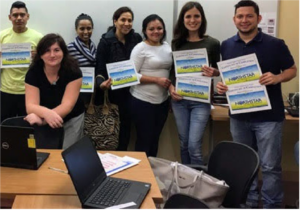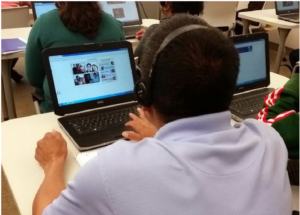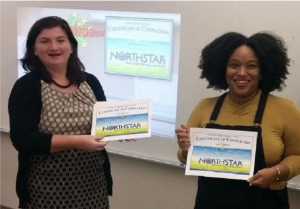Teaching with Technology at REEP

by Beatrice Lele and Hilary Major
English language learners work in pairs, leaning toward each other to show pictures they have snapped on their smartphones. As a warm up conversation activity, students are enthusiastically discuss-ing their photos. The teacher shares that she assigns photo topics that relate to classroom units, from food to careers; students often bring in photos from their own homes and workplaces.
Beginner level students collect vocabulary words that are used frequently at their workplace or describe a job they are interested in pursuing. Their teacher records the words on their mobile phones; students listen to the recording several times, practicing correct pronunciation. With the teacher, they review opening the saved sound file so they can retrieve it when they need it.
A volunteer instructor walks students through the process of using Skype, from connecting to WiFi and creating their own Skype accounts on their phones to talking in English with other students who are sitting in the center’s reception area or another classroom. Excited students are eager for more conversations.
These are just a few of the ways Arlington Education and Employment Program (REEP) educators have infused technology into their English language instruction. REEP’s mission is to prepare adults to achieve their personal, professional, and academic goals by providing the highest quality instruction for English, workplace skills, community participation, and digital literacy. REEP has a long history of investing in technology integration, thinking deeply about technology integration and incorporating computer labs in the 1990s; developing the REEPworld.org website in the early 2000s; and including a designated Instructional Technology Coordinator (ITC) position on staff for the past two decades. Current ITC Michele Cona emphasizes that the REEP curriculum, which is “student-centered and needs-based” leads the way. Technology can transform learning, but its role is to support instructional best practices and language and life-skill development. Over time, the focus has shifted from technology access to the digital literacy skills that will help students, even at the most basic levels, be self-sufficient. Today, students often come to REEP “with powerful communication devices in hand,” but face an environment in which a wide range of daily transactions are digital: a student-centered curriculum must work to ensure technology is not a barrier to adults’ ability to communicate. REEP teachers make the classroom decisions that support this goal, and program-wide professional development assists their efforts. Every in-service incorporates technology; instructors collaborate and share across sites using online workspaces such as wikis and Google Groups. “We have to model,” Michele says; to be effective instructors, teachers themselves need to use technology in “personally and professionally relevant ways.”



PROGRESS had the chance to interview two REEP teachers, Darlene Fahrenkrug and Micayla Burrows, about their use of technology. Darlene has taught most ESL levels at REEP, currently teaching intermediate and advanced conversation and pronunciation. Micayla is the digital literacy teacher, the IET coordinator for digital literacy, and an ESL teacher. Both have taught preparation courses for Northstar digital literacy certification. When asked what types of technology she uses in the classroom, Darlene provided a varied list, from hardware (a computer and projector, laptops, smartphones, smart pens) to social media and other interactive or collaborative platforms (Google Classroom, Gmail, Quizlet, Kahoot!, SlideShare) to websites selected primarily for their learning content (Breaking News English, Voice of America, YouTube, dictionary.com, collinsdictionary.com, gcflearnfree.org, sense-lang.org). Micayla shared a similarly diverse list of tech-based resources and instructional aids: “In the intensive English class every week, we use laptop computers during a computer lab. Computer lab activities range from using English language learning software to Internet navigation activities … We also use mobile devices for a range of activities including” messaging, email, polls, quizzes, and vocabulary practice. Her digital literacy class also utilizes Google Classroom for assignments and activities.
In discussing her technology choices, Darlene explained, “I look for meaningful ways to support what we are doing in class with extra practice and to provide additional resources for out-of-class extension or reference.” In her experience, it is best to start small and model each step in the process when first introducing technology, so that students don’t get overwhelmed. Later lessons can add additional steps or features, with students learning bit by bit as they progress. It can be helpful to give students “a checklist of steps so that they feel like they can do it on their own and be successful.” Micayla chooses technology based on how it complements REEP’s life-skills curriculum, how popular it is outside the classroom and with students, and userfriendliness. “For example,” she stated, “the majority of students in most of my technology assessments state that they currently use WhatsApp, so I choose to use WhatsApp as a class communication tool. WhatsApp messenger is extremely easy and accessible to use for the students.”
Students love being able to practice on their own and access resources independently.
“I begin by giving my class a technology needs assessment,” Micayla continued. “This self-assessment guides my technology use in the classroom. In a beginning level English class, I get my students connected to WiFi and using a communication tool like WhatsApp during the first week of class to have as a standard communication tool throughout the cycle. Every week, I build on the types of activities using WhatsApp. By the third or fourth week of the cycle, I introduce collaborative in-class activities using mobile devices, such as Kahoot! quizzes or Quizlet Live to practice the vocabulary and grammatical structures students have been learning. In the first two or three computer labs, I have students work on English language learning software, after I have the students use different practice sites on REEPworld.org, REEP’s online site for English practice. By the seventh week, I have the students compose an email about the topic they have been studying. In this past cycle, the students were studying housing and wrote an email describing their home. I have then grouped students in cross-ability pairs for a collaborative assignment using Google Docs. For example, after working to complete a simplified resumé in class, I have given each student in a group particular personal identification information for a fictional person. In a document I share with the group, the students complete an information gap activity to write a resumé. [In the next] computer lab, I have students write their own resumés using the same template on Google Docs.”
“Students love being able to practice on their own and access resources independently,” Darlene states. According to Micayla, “[w]ith technology, many more students are practicing English outside of class. … Communication tools such as WhatsApp allow for students to write or record short messages to the class in their free time as well as [communicate with teachers about] assignments, scheduling changes such as room changes, and other notifications.” The teachers monitor the success of their technology-integrated instruction through student feedback, including student surveys; formative assessment; and paying attention to increased class participation – and smiles. For Micayla, signs of success include students following up by email after class to clarify information and seeing students studying on their phones as they wait for class to start.
The teachers identified numerous benefits of teaching with technology. “[D]igital literacy skills and technology skills” are “becoming more and more necessary to succeed in the U.S.,” Micayla asserted. “Technology also allows students to be supported in more tailored, differentiated ways. Often it can help to make lessons personally relevant and multi-level.” Darlene also discussed technology’s ability to allow students to work at their own pace, adding that it “is especially useful for listening practice, because [students] can listen to something over and over again (sometimes at slower speeds) until they feel comfortable.”
There are challenges to introducing different technologies for classroom and student use. Both Darlene and Micayla noted that keeping up-to-date with a tech scene that constantly changing can be difficult. Darle shared that it’s not always easy to “figure which [tech tools] are going to be a good for your students. For ELLs, sometimes a g website will have instructions that are just wordy. … I look for resources that are free and don’t require an account.” For Micayla, the “biggest challenge is knowing how to teach and model technology skills in a way that doesn’t end up taking too much of the practice time.”
Finally, the REEP teachers provided a few recommendations for other instructors who want to increase their technology use:
- Remember to teach students information security and the skills to evaluate online content. “Digital literacy is critical for our students,” states Darlene. “It is important to practice in class so that students feel comfortable. They may use Facebook, but do they understand the privacy choices they are making or safe information to share online?”
- Micayla recommends “using at least three different types of technology in every class. It’s always good to test it out and become familiar with it, but the best advice I can give is to go for it! The best way to see what works, what doesn’t, and how to improve is trial and error.”
- “Even if [you or your students] don’t like computers, set a goal to take one small step this cycle,” Darlene encourages. “Try one new website or program that supports an activity in class. Allow time for things to go wrong and have a sense of humor about it.”
Learn More:
- Explore tech tips and other spotlight techniques on REEP’s YouTube Channel.
- Read Darlene Fahrenkrug’s blog post on using Quizlet for collaborative activities.
Beatrice Lele is a graduate student at Virginia Commonwealth University and graduate assistant at the Virginia Adult Learning Resource Center. Hillary Major is Instructional Standards and Communications Specialist at the Virginia Adult Learning Resource Center.